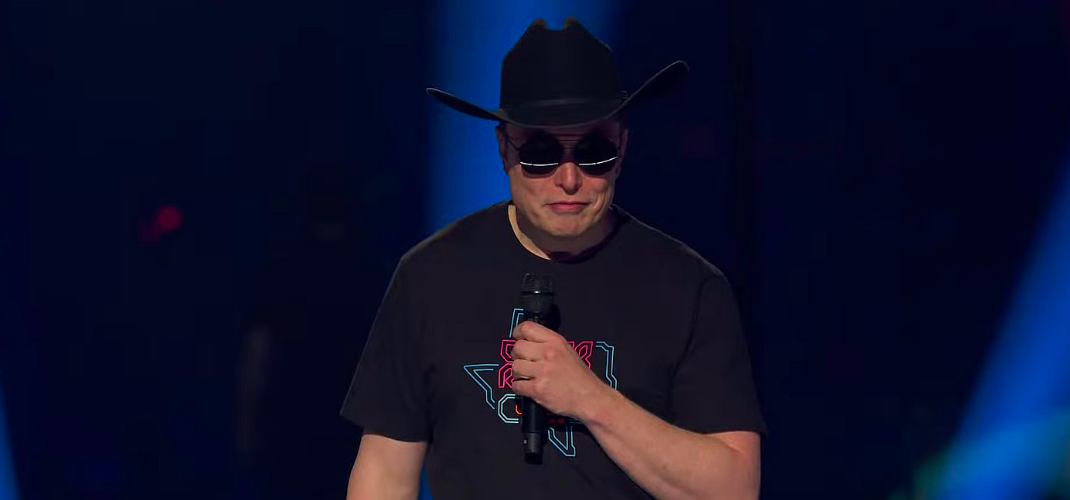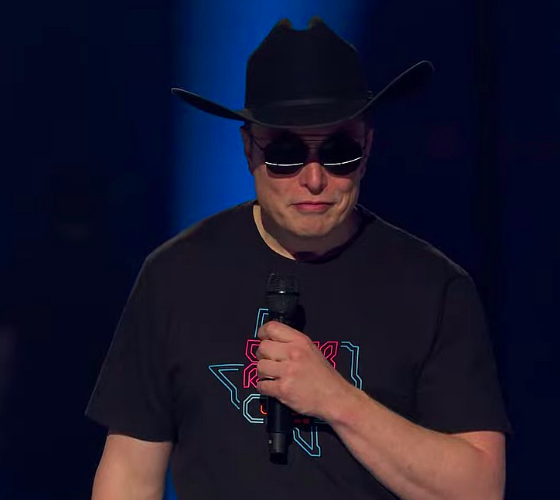Elon Musk recently joined a Twitter Spaces talk covering Tesla on Thursday and spoke on several topics such as the lithium refining factory in Corpus Christi, Texas, the recession, his goal of not selling any more Tesla stock for another 18-24 months, and more. The Spaces were hosted by @StockMKTNewz, @WholeMarsBlog, and @StockTalkWeekly.
Elon is currently in here join up https://t.co/wDQnUnM0vr
— Evan (@StockMKTNewz) December 22, 2022
Although you can go back and listen to the recording, Elon Musk gave a lot of detailed information and reassured Tesla shareholders that he wasn’t; he is still at Tesla. Here are five key takeaways from the live Twitter Spaces.
1. Elon Musk isn’t MIA at Tesla.
Several shareholders have been worried that Elon Musk’s focus on Twitter has been taking him away from Tesla. Elon Musk told Ross Gerber that he hasn’t missed a single important Tesla meeting.
“I was back in Austin just last week. There is literally not a single important Tesla meeting I have missed this entire time. I’m not MIA.”
He also told Gerber that he doesn’t have plants to sell any more Tesla stock until around 2025.
“I’m not selling any stock for another 18-24 months. Not until around 2025. I needed to sell. I’m not selling any stock until probably two years from now… I’m somewhat paranoid after going through two recessions.”
2. Tesla will weather any economic storms.
Regarding any upcoming economic issues, Elon Musk said he believed Tesla would weather it better than any company.
“I think Tesla will weather an upcoming economic storm better than any company. Unless the company is making bread.”
“If you are a ship in the storm, even if you have a great ship, you are still going to be hit. There is latency in the supply chain.”
3. Tesla’s lithium refinery.
In November, Tesla began negotiating for a battery-grade lithium refinery in Texas and discussed details of its planned $365 million plant with Nueces County commissioners. Elon Musk spoke briefly of the refinery during the Twitter Spaces.
“Tesla is building a lithium refinery in Texas to relieve the lithium refining choke point.”
“Seven years to build a refinery is insane. We are aiming to have meaningful volume out the factory in 2 years.”
“We are also cathode refining at Giga Texas for nickel-based cathodes.”
4. Next Gigafactory, recession & demand
Elon Musk added that the total automotive demand, especially the demand in China, will cause a reduction in the cost of battery materials. He added that Tesla is deploying capital at the fasted rate possible without being wasteful and then shared a bit of Gigafactory news.
“Deploying capital at the fastest rate we can without being wasteful. We are making investments, and can’t say too much, but we are close to picking a location for the next Gigafactory. We are being careful and deliberate about that. We are coming into recession in a strong position.”
5. Tesla Electric in Texas & Master Plan Part 3
Tesla recently launched Tesla Electric in Texas, which allows Powerwall owners to participate in virtual power plants (VPPs). This was a major milestone for both Tesla and Texas. Elon Musk said:
“The overarching purpose is to accelerate the advent of sustainable energy. Energy generation, storage of that energy, and electric transport. We are working on all three. The demand for large batteries is quasi-infinite. So long a Tesla battery pack is cheaper than a peaker plant, there will be insatiable demand.”
“1000+ GWh battery packs a year, if not 2000, is the goal. Master plan part 3 is really about scale. One should think of things in terms of tonnage. The fundamental rate limiter is how many gigawatt hours per year of battery packs can we make?”
“300 TWh of installed capacity for fully sustainable energy globally.”
Elon Musk also pointed out that the Tesla team is doing a phenomenal job and stands by his prediction that Tesla will be the most valuable company in the world.
Disclosure: Johnna is a $TSLA shareholder and believes in Tesla’s mission.
Your feedback is welcome. If you have any comments or concerns or see a typo, you can email me at johnna@teslarati.com. You can also reach me on Twitter at @JohnnaCrider1.
Teslarati is now on TikTok. Follow us for interactive news & more. Teslarati is now on TikTok. Follow us for interactive news & more. You can also follow Teslarati on LinkedIn, Twitter, Instagram, and Facebook.

Elon Musk
Elon Musk’s X will start using a Tesla-like software update strategy
The initiative seems designed to accelerate updates to the social media platform, while maintaining maximum transparency.

Elon Musk’s social media platform X will adopt a Tesla-esque approach to software updates for its algorithm.
The initiative seems designed to accelerate updates to the social media platform, while maintaining maximum transparency.
X’s updates to its updates
As per Musk in a post on X, the social media company will be making a new algorithm to determine what organic and advertising posts are recommended to users. These updates would then be repeated every four weeks.
“We will make the new 𝕏 algorithm, including all code used to determine what organic and advertising posts are recommended to users, open source in 7 days. This will be repeated every 4 weeks, with comprehensive developer notes, to help you understand what changed,” Musk wrote in his post.
The initiative somewhat mirrors Tesla’s over-the-air update model, where vehicle software is regularly refined and pushed to users with detailed release notes. This should allow users to better understand the details of X’s every update and foster a healthy feedback loop for the social media platform.
xAI and X
X, formerly Twitter, has been acquired by Elon Musk’s artificial intelligence startup, xAI last year. Since then, xAI has seen a rapid rise in valuation. Following the company’s the company’s upsized $20 billion Series E funding round, estimates now suggest that xAI is worth tens about $230 to $235 billion. That’s several times larger than Tesla when Elon Musk received his controversial 2018 CEO Performance Award.
As per xAI, the Series E funding round attracted a diverse group of investors, including Valor Equity Partners, Stepstone Group, Fidelity Management & Research Company, Qatar Investment Authority, MGX, and Baron Capital Group, among others. Strategic partners NVIDIA and Cisco Investments also continued support for building the world’s largest GPU clusters.
News
Tesla FSD Supervised wins MotorTrend’s Best Driver Assistance Award
The decision marks a notable reversal for the publication from prior years, with judges citing major real-world improvements that pushed Tesla’s latest FSD software ahead of every competing ADAS system.

Tesla’s Full Self-Driving (Supervised) system has been named the best driver-assistance technology on the market, earning top honors at the 2026 MotorTrend Best Tech Awards.
The decision marks a notable reversal for the publication from prior years, with judges citing major real-world improvements that pushed Tesla’s latest FSD software ahead of every competing ADAS system. And it wasn’t even close.
MotorTrend reverses course
MotorTrend awarded Tesla FSD (Supervised) its 2026 Best Tech Driver Assistance title after extensive testing of the latest v14 software. The publication acknowledged that it had previously criticized earlier versions of FSD for erratic behavior and near-miss incidents, ultimately favoring rivals such as GM’s Super Cruise in earlier evaluations.
According to MotorTrend, the newest iteration of FSD resolved many of those shortcomings. Testers said v14 showed far smoother behavior in complex urban scenarios, including unprotected left turns, traffic circles, emergency vehicles, and dense city streets. While the system still requires constant driver supervision, judges concluded that no other advanced driver-assistance system currently matches its breadth of capability.
Unlike rival systems that rely on combinations of cameras, radar, lidar, and mapped highways, Tesla’s FSD operates using a camera-only approach and is capable of driving on city streets, rural roads, and freeways. MotorTrend stated that pure utility, the ability to handle nearly all road types, ultimately separated FSD from competitors like Ford BlueCruise, GM Super Cruise, and BMW’s Highway Assistant.
High cost and high capability
MotorTrend also addressed FSD’s pricing, which remains significantly higher than rival systems. Tesla currently charges $8,000 for a one-time purchase or $99 per month for a subscription, compared with far lower upfront and subscription costs from other automakers. The publication noted that the premium is justified given FSD’s unmatched scope and continuous software evolution.
Safety remained a central focus of the evaluation. While testers reported collision-free operation over thousands of miles, they noted ongoing concerns around FSD’s configurable driving modes, including options that allow aggressive driving and speeds beyond posted limits. MotorTrend emphasized that, like all Level 2 systems, FSD still depends on a fully attentive human driver at all times.
Despite those caveats, the publication concluded that Tesla’s rapid software progress fundamentally reshaped the competitive landscape. For drivers seeking the most capable hands-on driver-assistance system available today, MotorTrend concluded Tesla FSD (Supervised) now stands alone at the top.
News
Elon Musk’s Grokipedia surges to 5.6M articles, almost 79% of English Wikipedia
The explosive growth marks a major milestone for the AI-powered online encyclopedia, which was launched by Elon Musk’s xAI just months ago.

Elon Musk’s Grokipedia has grown to an impressive 5,615,201 articles as of today, closing in on 79% of the English Wikipedia’s current total of 7,119,376 articles.
The explosive growth marks a major milestone for the AI-powered online encyclopedia, which was launched by Elon Musk’s xAI just months ago. Needless to say, it would only be a matter of time before Grokipedia exceeds English Wikipedia in sheer volume.
Grokipedia’s rapid growth
xAI’s vision for Grokipedia emphasizes neutrality, while Grok’s reasoning capabilities allow for fast drafting and fact-checking. When Elon Musk announced the initiative in late September 2025, he noted that Grokipedia would be an improvement to Wikipedia because it would be designed to avoid bias.
At the time, Musk noted that Grokipedia “is a necessary step towards the xAI goal of understanding the Universe.”
Grokipedia was launched in late October, and while xAI was careful to list it only as Version 0.1 at the time, the online encyclopedia immediately earned praise. Wikipedia co-founder Larry Sanger highlighted the project’s innovative approach, noting how it leverages AI to fill knowledge gaps and enable rapid updates. Netizens also observed how Grokipedia tends to present articles in a more objective manner compared to Wikipedia, which is edited by humans.
Elon Musk’s ambitious plans
With 5,615,201 total articles, Grokipedia has now grown to almost 79% of English Wikipedia’s article base. This is incredibly quick, though Grokipedia remains text-only for now. xAI, for its part, has now updated the online encyclopedia’s iteration to v0.2.
Elon Musk has shared bold ideas for Grokipedia, including sending a record of the entire knowledge base to space as part of xAI’s mission to preserve and expand human understanding. At some point, Musk stated that Grokipedia will be renamed to Encyclopedia Galactica, and it will be sent to the cosmos.
“When Grokipedia is good enough (long way to go), we will change the name to Encyclopedia Galactica. It will be an open source distillation of all knowledge, including audio, images and video. Join xAI to help build the sci-fi version of the Library of Alexandria!” Musk wrote, adding in a later post that “Copies will be etched in stone and sent to the Moon, Mars and beyond. This time, it will not be lost.”










